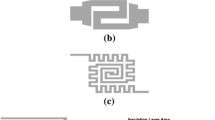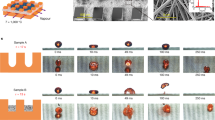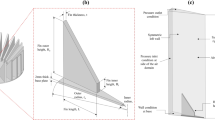Abstract
In this paper, a two-step method is proposed to optimize the layout of the conventional serpentine film heater thus to improve the temperature uniformity. The optimization is made on transverse direction firstly with varied linewidths and pitches, and then on longitudinal direction with varied line shapes. Based on finite element simulation using a flow field approach, the heater geometry evolution dependent on temperature uniformity is investigated. The results show that the isothermal region extends greatly in transverse direction by the first step, while it extends subsequently in longitudinal direction by the second step and simultaneously shrinks in transverse direction. By a proper tradeoff between these two modification steps, the substrate area within 96.4% temperature uniformity increases by more than five times in comparison to the conventional serpentine heater. This area is even larger by 5% than that achieved by an optimized spiral heater, indicating that the serpentine heater is more powerful to adjust the temperature uniformity. Moreover, the optimized serpentine heater realizes a coverage ratio as high as 86.64% on a rectangular membrane, demonstrating that serpentine heaters are more flexible to substrate shapes than spiral heaters to achieve a uniform and large area temperature distribution.








Similar content being viewed by others
References
Agah M, Potkay JA, Lambertus G, Sacks R, Wise KD (2005) High-performance temperature-programmed microfabricated gas chromatography columns. J Microelectromech Syst 14(5):1039–1050
Aigner R, Dietl M, Katterloher R, Klee V (1995) Si-planar-pellistor: designs for temperature modulated operation. Sens Actuators B 33(1):151–155
Aigner R, Dietl M, Katterloher R, Klee V (1996) Si-planar-pellistor: designs for temperature modulated operation. Sens Actuators B 33(1–3):151–155
Arata HF, Rondelez Y, Noji H, Fujita H (2005) Temperature alternation by an on-chip microheater to reveal enzymatic activity of β-galactosidase at high temperatures. Anal Chem 77(15):4810–4814
Astie S, Gue AM, Scheid E, Lescouzeres L, Cassagnes A (1998) Optimization of an integrated SnO2 gas sensor using a FEM simulator. Sens Actuators A 69(3):205–211
Baroncini M, Placidi P, Cardinali GC, Scorzoni A (2004) Thermal characterization of a microheater for micromachined gas sensors. Sens Actuators A 115(1):8–14
Briand D, Heimgartner S, Grétillat MA, Bart VDS, De Rooij NF (2002a) Thermal optimization of micro-hotplates that have a silicon island. J Micromech Microeng 12(12):971–978
Briand D, Schoot BVD, Rooij NFD, Sundgren H, Lundstrom I (2002b) A low-power micromachined MOSFET gas sensor. J Microelectromech Syst 9(3):303–308
Cardinali G, Dori L, Fiorini M, Sayago I (1997) A smart sensor system for carbon monoxide detection. Analog Integr Circ Sig Process 296:275–296
Chung GS, Jeong JM (2010) Fabrication of micro heaters on polycrystalline 3C-SiC suspended membranes for gas sensors and their characteristics. Microelectron Eng 87(11):2348–2352
Comsol.com (2017) http://cn.comsol.com/model/download/396341/models.heat.vacuum_flask.pdf/. Accessed Nov 2017
Courbat J, Briand D, De Rooij NF (2009) Reliability improvement of suspended platinum-based micro-heating elements. Sens Actuators A 142(1):284–291
Courbat J, Canonica M, Teyssieux D, Briand D, De Rooij NF (2010) Design and fabrication of micro-hotplates made on a polyimide foil: electrothermal simulation and characterization to achieve power consumption in the low mw range. J Micromech Microeng 21(1):196–201
Dai CL (2007) A capacitive humidity sensor integrated with micro heater and ring oscillator circuit fabricated by CMOS-MEMS technique. Sens Actuators B 122:375–380
Greve A, Olsen JK, Boisen A, Privorotskaya N, King WP, Senesac L, Thundat T (2009) Micro-calorimetric sensor for vapour phase explosive detection with optimized heat profile. In: Proceedings of IEEE sensors 2009 conference-SENSORS 2009, pp 723–726
Hamid NA, Majlis BY, Yunas J, Syafeeza AR, Yan CW, Ibrahim M (2016) A stack bonded thermo-pneumatic micro-pump utilizing polyimide based actuator membrane for biomedical applications. Microsyst Technol 23(9):1–7
Hildenbrand J, Korvink J, Wollenstein J, Peter C, Kurzinger A, Naumann F, Ebert M, Lamprecht F (2010) Micromachined mid-infrared emitter for fast transient temperature operation for optical gas sensing systems. Sens J IEEE 10(2):353–362
Hille P, Strack H (1992) A heated membrane for a capacitive gas sensor. Sens Actuators A 32(1–3):321–325
Huber DL, Manginell RP, Samara MA, Kim BI, Bunker BC (2003) Programmed adsorption and release of proteins in a microfluidic device. Science 301(5631):352–354
Hwang WJ, Shin KS, Roh JH, Lee DS, Choa SH (2011) Development of micro-heaters with optimized temperature compensation design for gas sensors. Sensors 11(3):2580
Khan U, Falconi C (2013) Micro-hot-plates without simply connected hot-spots and with almost-circular temperature distribution. Sens Actuators B 185(8):274–281
Laconte J, Dupont C, Flandre D, Raskin JP (2004) SOI CMOS compatible low-power microheater optimization for the fabrication of smart gas sensors. J Sens IEEE 4(5):670–680
Lee SM, Dyer DC, Gardner JW (2003) Design and optimisation of a high-temperature silicon micro-hotplate for nanoporous palladium pellistors. Microelectron J 34(2):115–126
Lee CY, Liu CC, Chen SC, Chiang CM, Su YH, Kuo WC (2011) High-performance MEMS-based gas chromatography column with integrated micro heater. Microsyst Technol 17(4):523–531
Li T, Wu L, Liu Y, Wang L, Wang Y, Wang, YL (2006) Micro-heater on membrane with large uniform-temperature area. In: Proceedings of 2006 5th IEEE conference on sensors, pp 571–575
Liu B, Hou Y, Li D, Yang J (2015) A thermal bubble micro-actuator with induction heating. Sens Actuators A 222(222):8–14
Lu CC, Liao KH, Udrea F, Covington JA, Gardner JW (2008) Multi-field simulations and characterization of CMOS-MEMS high-temperature smart gas sensors based on SOI technology. J Micromech Microeng 18(7):075010
Mele L, Rossi T, Riccio M, Iervolino E, Santagata F, Irace A, Breglio G, Creemer JF, Sarro PM (2011) Electro-thermal analysis of MEMS microhotplates for the optimization of temperature uniformity. Proc Eng 25(35):387–390
Moschou D, Vourdas N, Kokkoris G, Papadakis G, Parthenios J, Chatzandroulis S, Tserepi A (2014) All-plastic, low-power, disposable, continuous-flow PCR chip with integrated microheaters for rapid DNA amplification. Sens Actuators 199:470–478
Partridge JG, Field MR, Sadek AZ, Kalantar-Zadeh K, Du Plessis J, Taylor MB, McCulloch DG (2009) Fabrication, structural characterization and testing of a nanostructured tin oxide gas sensor. Sens J IEEE 9(5):563–568
Prajesh R, Jain N, Agarwal A (2016) Low power highly sensitive platform for gas sensing application. Microsyst Technol 9:1–8
Privorotskaya NL, King WP (2009) Silicon microcantilever hotplates with high temperature uniformity. Sens Actuators A 152(2):160–167
Saxena G, Paily R (2013) Choice of insulation materials and its effect on the performance of square microhotplate. Microsyst Technol 21(2):393–399
Saxena G, Paily R (2015) Performance improvement of square microhotplate with insulation layer and heater geometry. Microsyst Technol 21(11):2331–2338
Sidek O, Ishak MZ, Khalid MA, Bakar MZA,Miskam MA (2011) Effect of heater geometry on the high temperature distribution on a MEMS micro-hotplate. In: Proceedings of the 3rd Asia symposium on quality electronic design, pp 100–104
Simon I, Bârsan N, Bauer M, Weimar U (2001) Micromachined metal oxide gas sensors: opportunities to improve sensor performance. Sens Actuators B 73(1):1–26
Solzbacher F, Imawan C, Steffes H, Obermeier E, Möller H (2000) A modular system of SiC-based microhotplates for the application in metal oxide gas sensors. Sens Actuators B 64(1–3):95–101
Spannhake J, Schulz O, Helwig A, Krenkow A, Müller G, Doll T (2006) High-temperature MEMS heater platforms: long-term performance of metal and semiconductor heater materials. Sensors 6(4):405–419
Spannhake J, Helwig A, Müller G, Faglia G, Sberveglieri G, Doll T (2007) SnO2:Sb—a new material for high-temperature MEMS heater applications: performance and limitations. Sens Actuators B 124:421–428
Tian WC, Wu TH, Lu CJ, Chen WR, Sheen HJ (2012) A novel micropreconcentrator employing a laminar flow patterned heater for micro gas chromatography. J Micromech Microeng 22(6):65014–65021
Velmathi G, Ramshanker N, Mohan S (2010) Design, electro-thermal simulation and geometrical optimization of double spiral shaped microheater on a suspended membrane for gas sensing. In: IEEE IECON 2010, conference on IEEE industrial electronics society, pp 1258–1262
Vereshchagina E, Tiggelaar RM, Sanders RGP, Wolters RAM, Gardeniers JGE (2015) Low power micro-calorimetric sensors for analysis of gaseous samples. Sens Actuators B 206:772–787
Wang B, Lin Q (2013) Temperature-modulated differential scanning calorimetry in a mems device. Sens Actuators B 180(10):60–65
Wu S, Lin Q, Yin Y, Tai YC (2001) Mems flow sensors for nano-fluidic applications. Sens Actuators A 89(1–2):152–158
Wu YE, Chen K, Chen CW, Hsu KH (2002) Fabrication and characterization of thermal conductivity detectors (TCDs) of different flow channel and heater designs. Sens Actuators A 100(1):37–45
Xu L, Li T, Wang Y (2011) A novel three-dimensional microheater. IEEE Electron Device Lett 32(9):1284–1286
Yoon JH, Kim BJ, Kim JS (2012) Design and fabrication of micro hydrogen gas sensors using palladium thin film. Mater Chem Phys 133(2–3):987–991
Yu S, Wang S, Lu M, Zuo L (2017) A novel polyimide based micro heater with high temperature uniformity. Sens Actuators A Phys 257:58–64
Zhang FT, Tang Z, Yu J, Jin RC (2006) A micro-pirani vacuum gauge based on micro-hotplate technology. Sens Actuators A 126(2):300–305
Zheng C, Balasubramanian GPS, Tan Y, Maniatty AM, Hull R, Wen JT (2017) Simulation, microfabrication, and control of a microheater array. IEEE/ASME Trans Mechatron 22(4):1914–1919
Acknowledgements
This work was partially supported by National Science Founds of China (Grant no. 61771112) and National Science Founds for Creative Research Groups of China (no. 6142100).
Author information
Authors and Affiliations
Corresponding author
Additional information
Publisher's Note
Springer Nature remains neutral with regard to jurisdictional claims in published maps and institutional affiliations.
Rights and permissions
About this article
Cite this article
Wu, Y., Du, X., Li, Y. et al. Optimization of temperature uniformity of a serpentine thin film heater by a two-dimensional approach. Microsyst Technol 25, 69–82 (2019). https://doi.org/10.1007/s00542-018-3932-0
Received:
Accepted:
Published:
Issue Date:
DOI: https://doi.org/10.1007/s00542-018-3932-0




